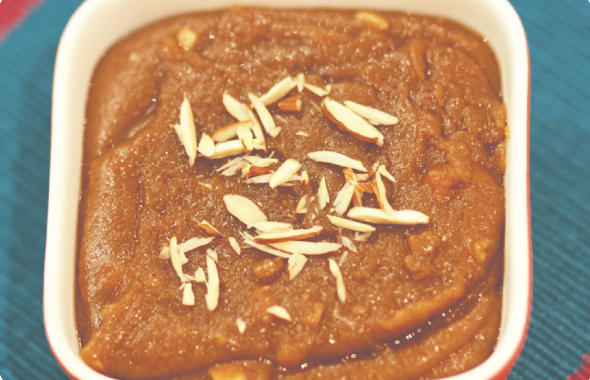Mama’s Punjabi Recipes – Letti Halwa (Thin Wheat Flour Pudding)
If a true Punjabi was served halwa – especially suji halwa (semolina halwa) or atte da halwa (wheat flour halwa), his first reaction would be “Kyon, ki manande peye han?” or “What are we celebrating?” because halwa, in Punjabi society, is usually made to commemorate a special occasion, glad tidings or a stroke of good luck. And almost always, it is distributed among friends. I always make suji halwa on the birthdays of my family members and ask them to first get it blessed at our home temple before anyone takes the first bite.
Apart from these two, there are two other types of atte da halwa that are made in the Punjab for special occasions – panjeeri (dry wheat flour halwa) which is passed out as blessed food in temples and letti (thin wheat flour halwa) which is usually given to sick people or those with head colds as a tonic to give them strength, especially during the cold winter months. In a way, letti is to gaining strength what khiciddi is to helping with indigestion.
And in the same way, letti is a really thin version of the regular atte da halwa and is made with a lot of water. In some other parts of India is also called sheera. It is a tasty old-fashioned home remedy from the Punjab villages that seems to work and is really fast and easy to make. Some people add crushed dry fruits like almonds, walnuts and pistachios to give more nourishment.
Ingredients:
½ cup kanak (gehon) ka atta (wheat flour) or besan (chickpea flour)
½ cup ghee (clarified butter)
½ cup chinni (sugar)
2 cups warm pani (water)
Directions:
1. In a saucepan warm up the ghee over medium heat.
2. Throw in the flour and brown while stirrings continuously. Be careful it does not burn.
3. Stir in the warm water and let the mixture come to a boil.
4. Now add the sugar and let the mixture boil for five minutes.
5. Turn off the heat. The letti is ready to eat.
Shakuntla Malhotra is a skilled cook of Punjabi dishes made in the old-fashioned style that she learnt as a young woman in her ancestral home in Lyallpur, India before it became part of Pakistan after the Partition in 1947. People have often admired her cooking for its simplicity and taste that comes with each mouthful. Even in her mid-eighties, she continues to cook daily and agreed to share some of her delectable Punjabi recipes.
MAMA’S TIP OF THE WEEK
CLEAN A HOT TAVA WITH SOME ATTA DOUGH
After a while of making roti or paranthas, the tava (flatplate) often gets coated with a small amount of the residue left over from the cooking atta (flour). This can get stuck onto the next batch of rotis or paranthas that you will make and leaves black spots on them. You can scrape them residue off but them you may leave scratches on the tava. Since tavas are not usually washed on a daily basis but kept clean by the heat, there is an easier way to keep them clean. Simply use a small pinch of freshly cooked atta dough to dab the residue off a warm tava. The flakes will come right off and you can throw the dough ball away.


